9 Surprising SUP Yoga Poses You’ll Want to Try This Summer
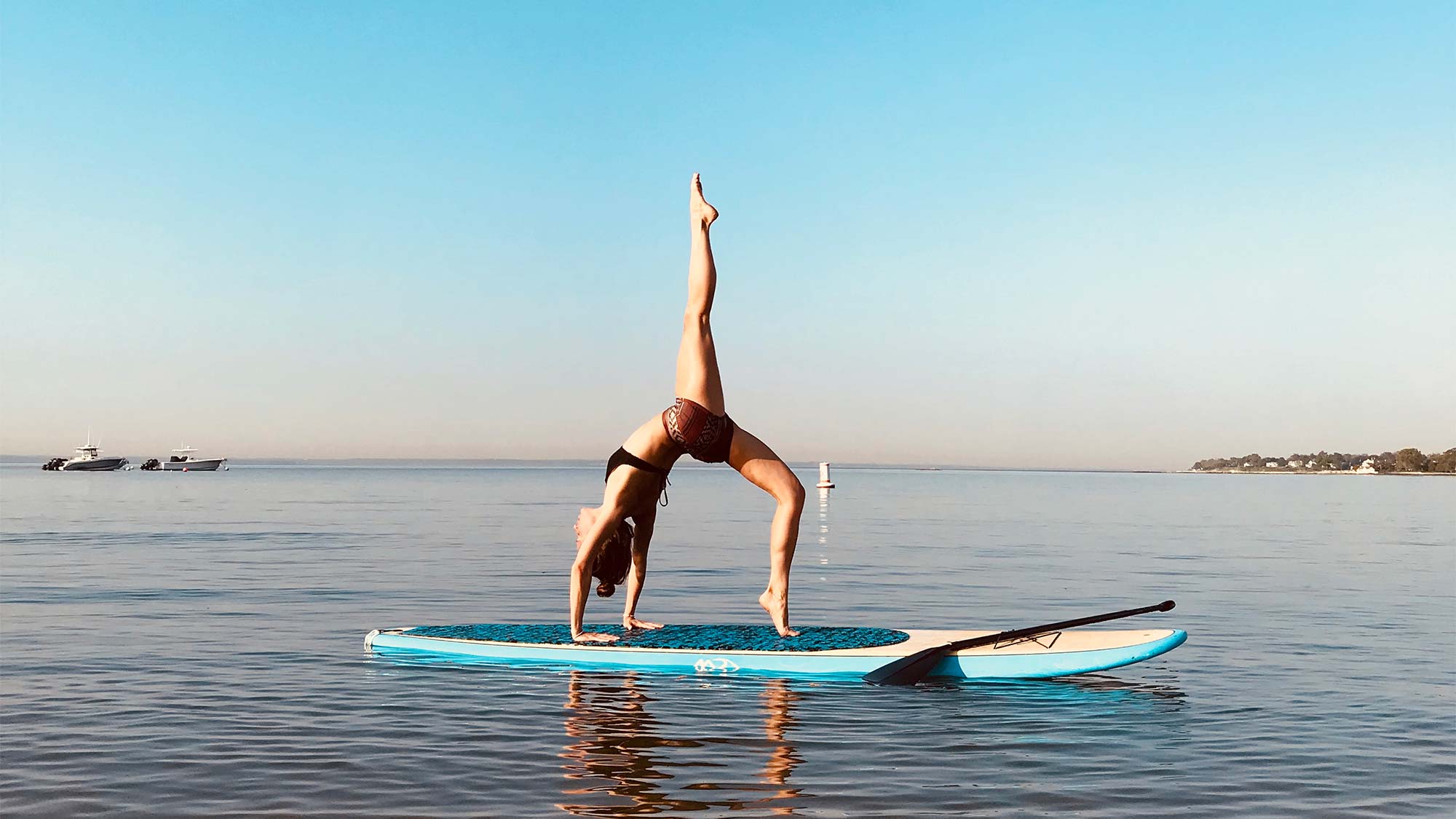
For many of us, standup paddleboard (SUP) yoga has come to be synonymous with summer. After all, it’s a great way to enjoy being out on the water and to sneak in some core-challenging yoga poses—not to mention have your Instagram husband snap a wow-worthy photo while you’re holding Headstand on your board.
If you’re a beginner SUP yoga student, you’re likely discovering that practicing yoga on a paddleboard can inform your “land” practice by challenging your balance and helping you realize the importance of focus. Once you feel comfortable with the basics and you’ve got a steady SUP yoga practice, you might be eager to try more challenging postures on your board. Enter this sequence, which is filled with familiar postures that have unexpected variations.
SUP Yoga Warm-Up
Begin to warm up the hips and shoulders with postures like Child’s Pose, holding the sides (or rails) of one side of the board and then the other. Include several vinyasas like Cat/Cow or Downward-Facing Dog to Plank, going with the flow of the breath coupled with the feel of the water beneath the board. Place yourself on this small, private island-like space, pairing each movement with a long breath. This is not a race. Take your time, not just to assist with balance, mindfully building a foundation, but also to widen your attention and commune with nature above, around, and below.
9 Surprising SUP Yoga Poses to Try This Summer
1. Tabletop Variation
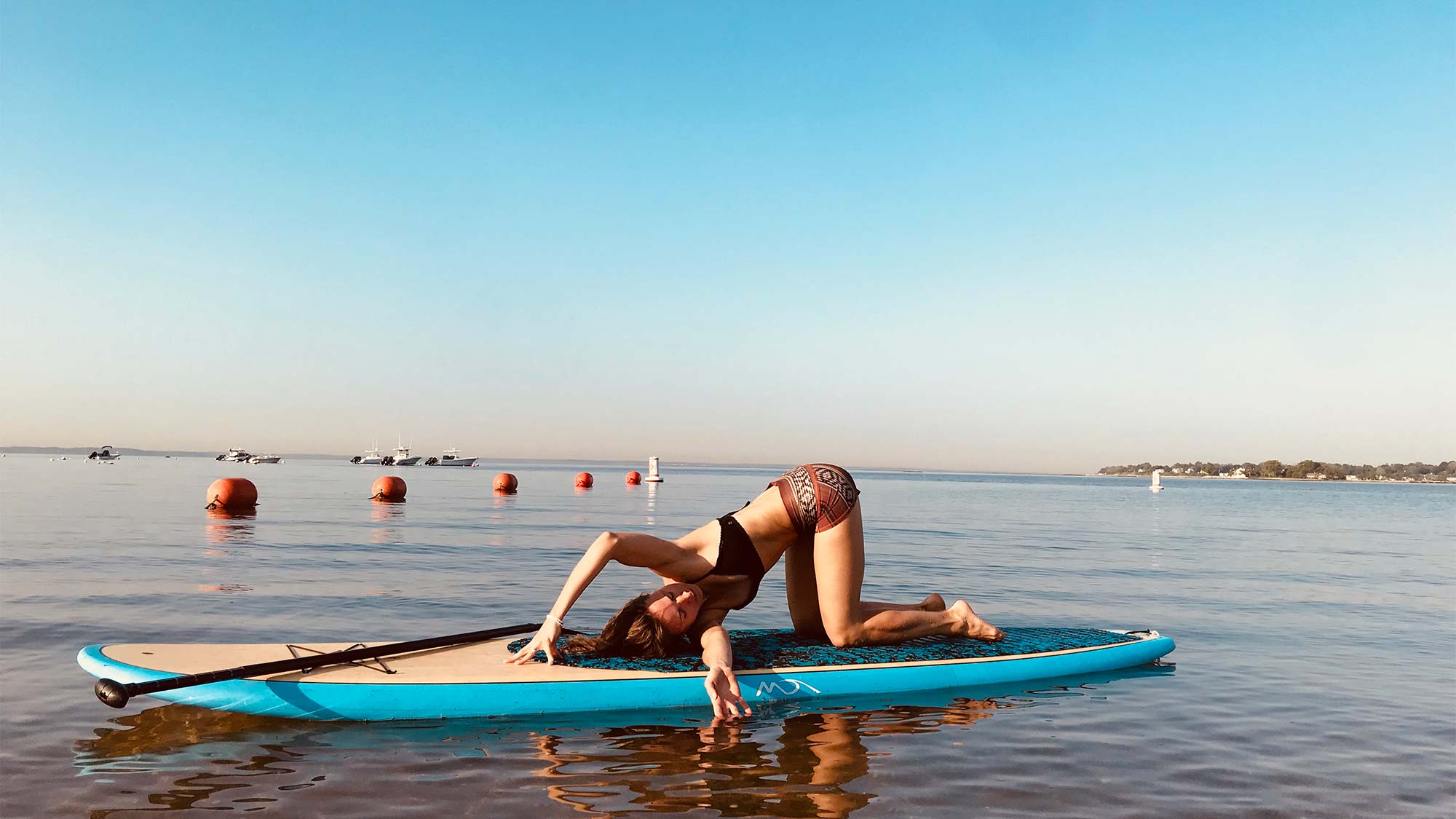
Start in Tabletop. Then, play with lifting the opposite arm and opposite leg to integrate the sensation of hugging to the midline as you challenge your stability. Consider the four corners of hand, hand, knee, and knee in Tabletop, and ground down hand and opposite knee on the board to hold down the sides (or rails) of the board and minimize the rock. Then, lift your right arm up to the sky and thread the needle of the right arm under the left arm. Depending on the board’s width and your personal wingspan, you might be able to reach your left hand toward the right rails while you dip the back of your right hand into the water. Send your hips back and away from your shoulders. With an ear on the board, hear the incessant tap, tap, tap, tap of the water. There’s always an opportunity to reengage with your balance when it becomes amiss. Take five complete breaths and switch sides.
2. Camel Pose Flow
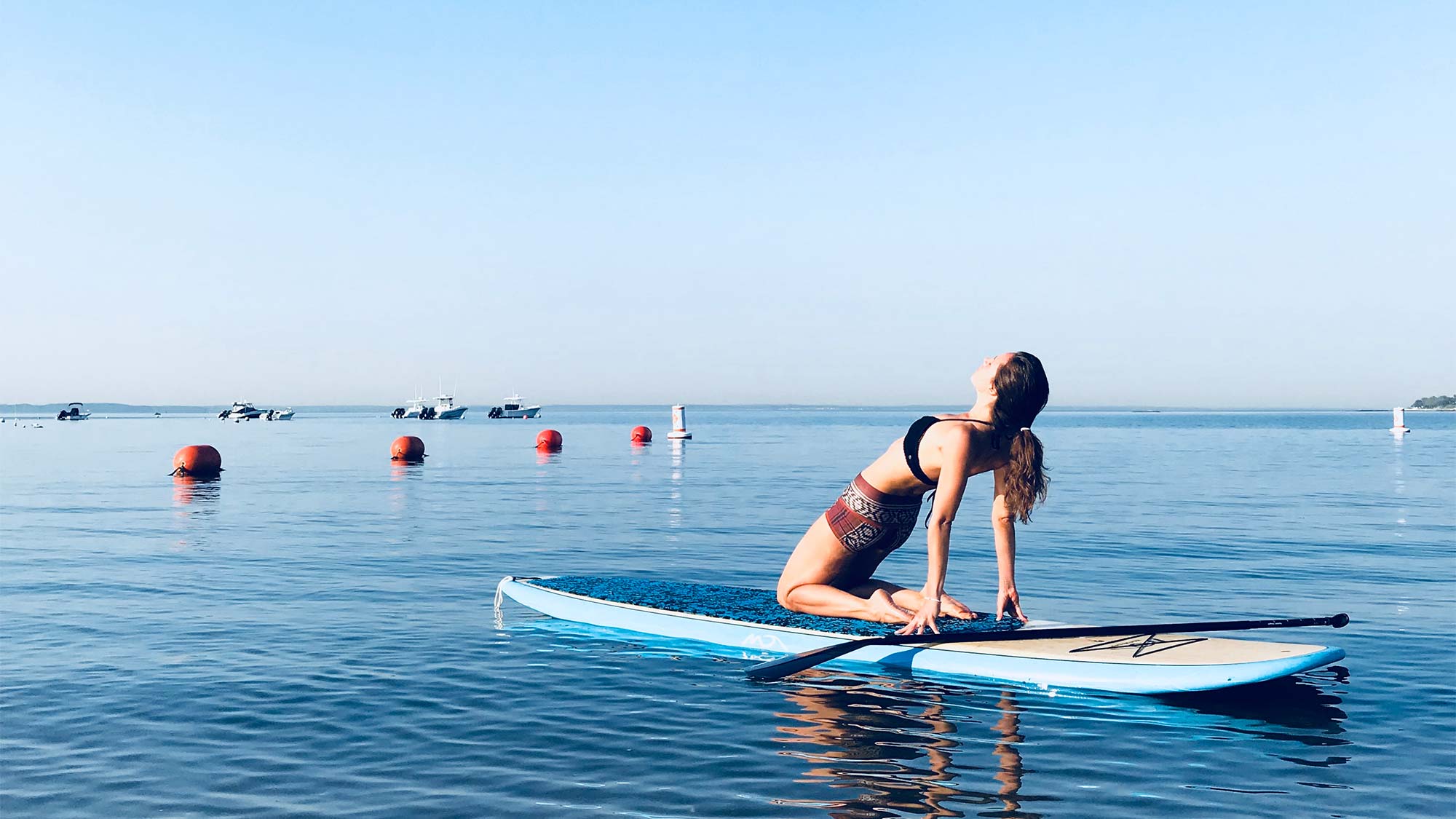
Take Downward-Facing Dog, pressing down into both hands as wide as your outer shoulders and into the balls of your feet. Bend your knees, work them as wide as your heels, and reach your hips away from your hands, feeling the stretch along the sides of the body and hips and down the backs of the legs. Then, float your knees down to Tabletop, swim your arms back behind your feet with fingers facing the opposite way, and open your shoulders and hips as you rise up away from your heels into a Camel Pose variation. Stay for a breath and with the shoulders broad and the chest receiving, feel the sun press from above the clouds. Come back to rest on the heels for a breath, then into Tabletop for a breath, and then like another set of waves, repeat the sequence three more times. It’s OK to feel unsure, unsteady, and unprepared. This flow is playful and can be perceived as such, like a splash in the ocean waves after a long winter.
See also The Post-SUP Yoga Sequence for Beginner Standup Paddlers
3. Fallen Triangle
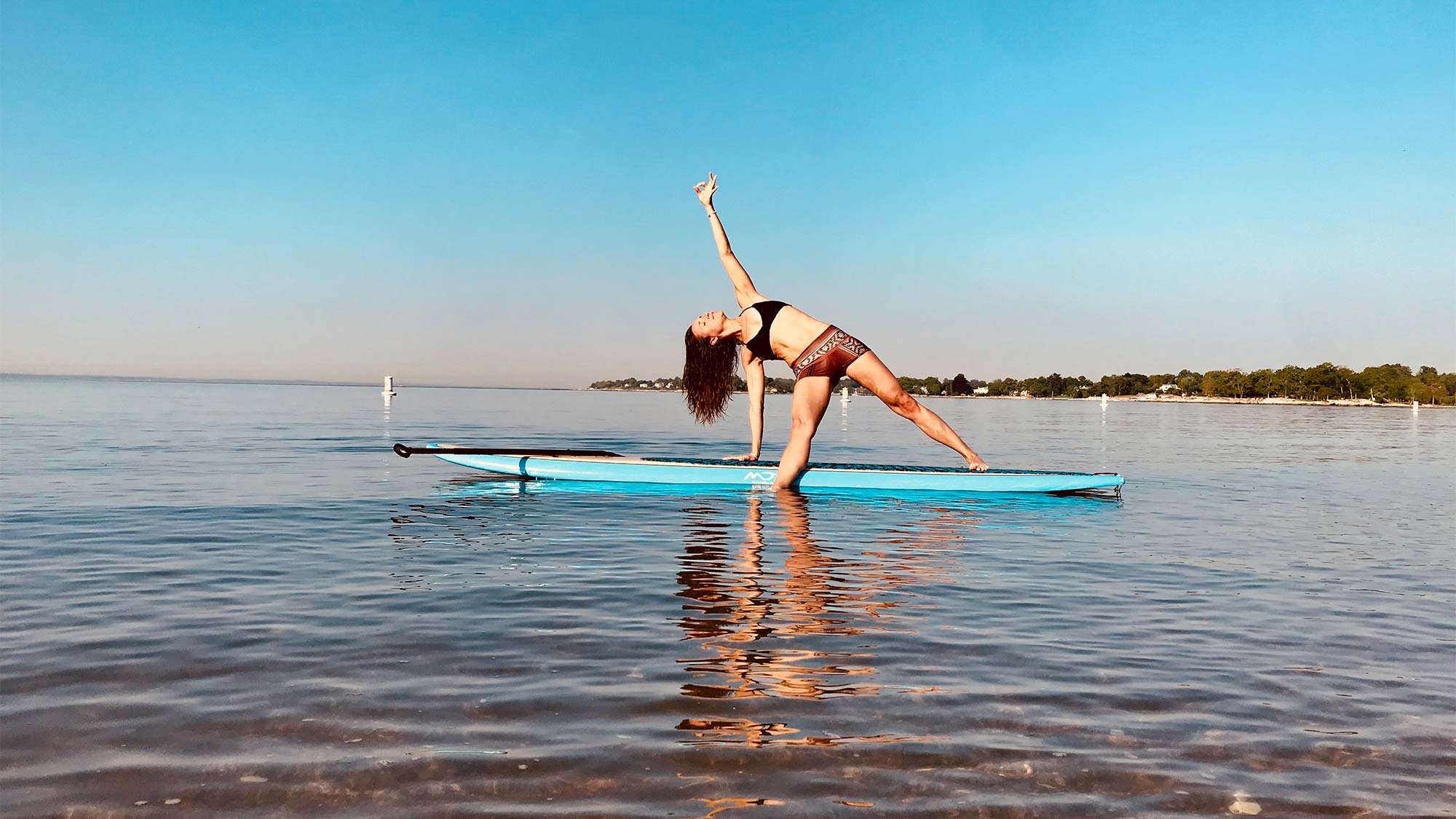
From Downward-Facing Dog, move your feet to touch and lift your right leg up into the sky. Bend your knee and open your hip to the blue sky around. In this feeling of openness, relax your opposite heel down and recall how you’ve probably been told to level the shoulders in this pose in a studio class. Feel the importance of that instruction and its application to balance, now on the board. Then bring your lifted leg to cross through your left arm to the outside of the board. Roll to the inner rim of your left foot and hug the board significantly with your right shin. Lift your left arm up into the sky, bend softly at the elbow, and backbend open to the fluffy clouds above. Once complete, slide your right knee back over to the right behind your right wrist, and float down into Pigeon Pose to counter the outward expression of the backbend. Take several breaths with the head down before pressing back into Downward-Facing Dog and moving through Fallen Triangle on the opposite side.
See also SUP Yoga: Standup Paddle Pics to Get You Psyched for Summer
4. Tree Pose
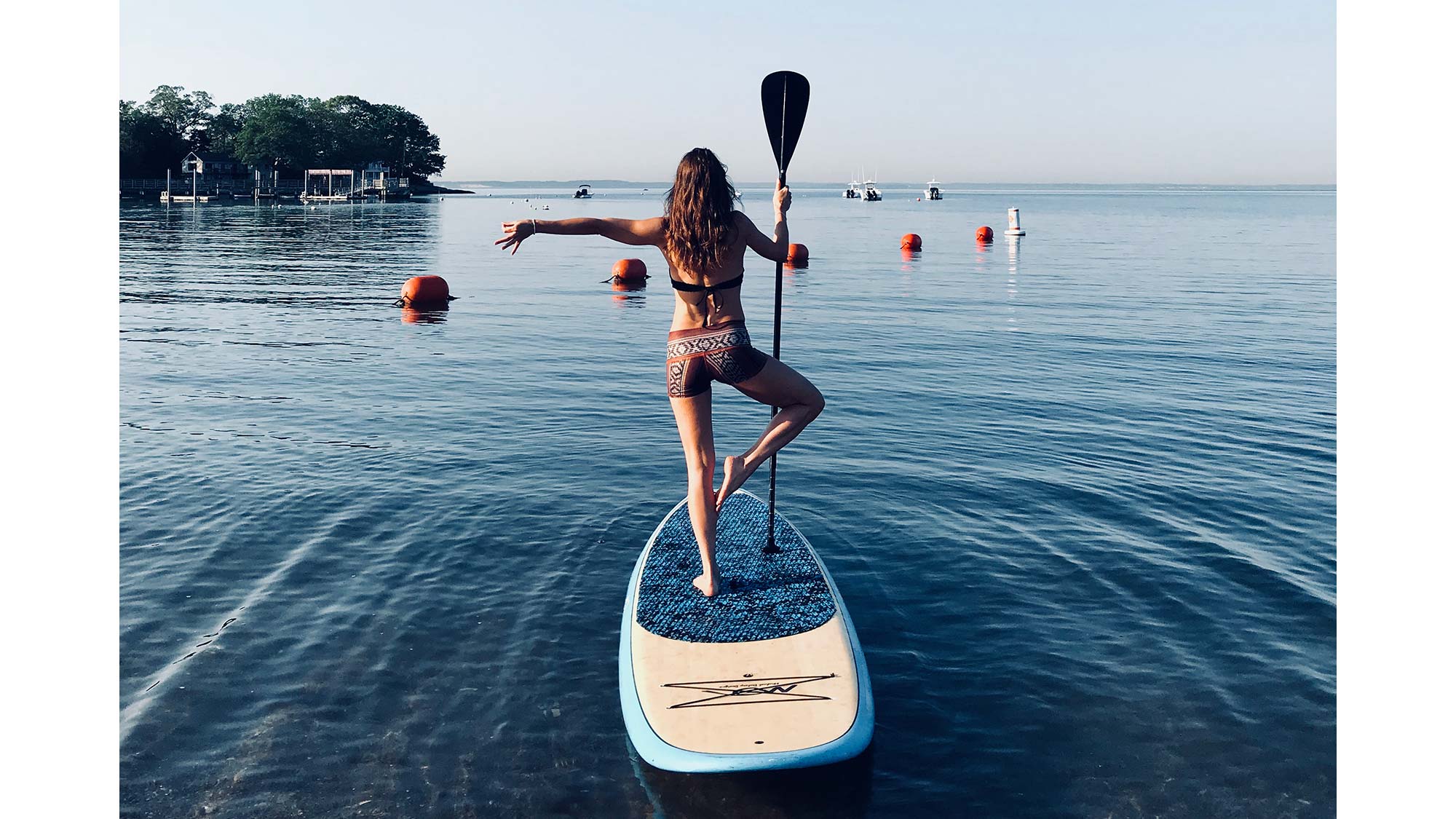
To balance on one foot on a paddleboard is not an easy feat. The paddle may be used in standing poses like Tree Pose to assist with balance and make this challenging pose more accessible. Start in a standing position, place your left foot toward the center of the board, and turn it out to the side (establishing a wider base). Ground down the paddle with your right hand, with the paddle perpendicular to the board and the handle side down to protect the blade of the paddle. Use the paddle handle like a complement to the standing foot, simulating two feet down on the board. Extend your left hand out to the left like a wing on a plane and slowly lift the right heel or the entire foot, pressing down into the standing foot and paddle handle and pressing together foot and shin. Do these when the boats have passed and their wakes are at a minimum, and cut yourself some slack please. Hold for one full breath or several. Give it a go on the other side at your leisure.
See also 4 Yoga Poses to Try On Your SUP
5. Warrior III
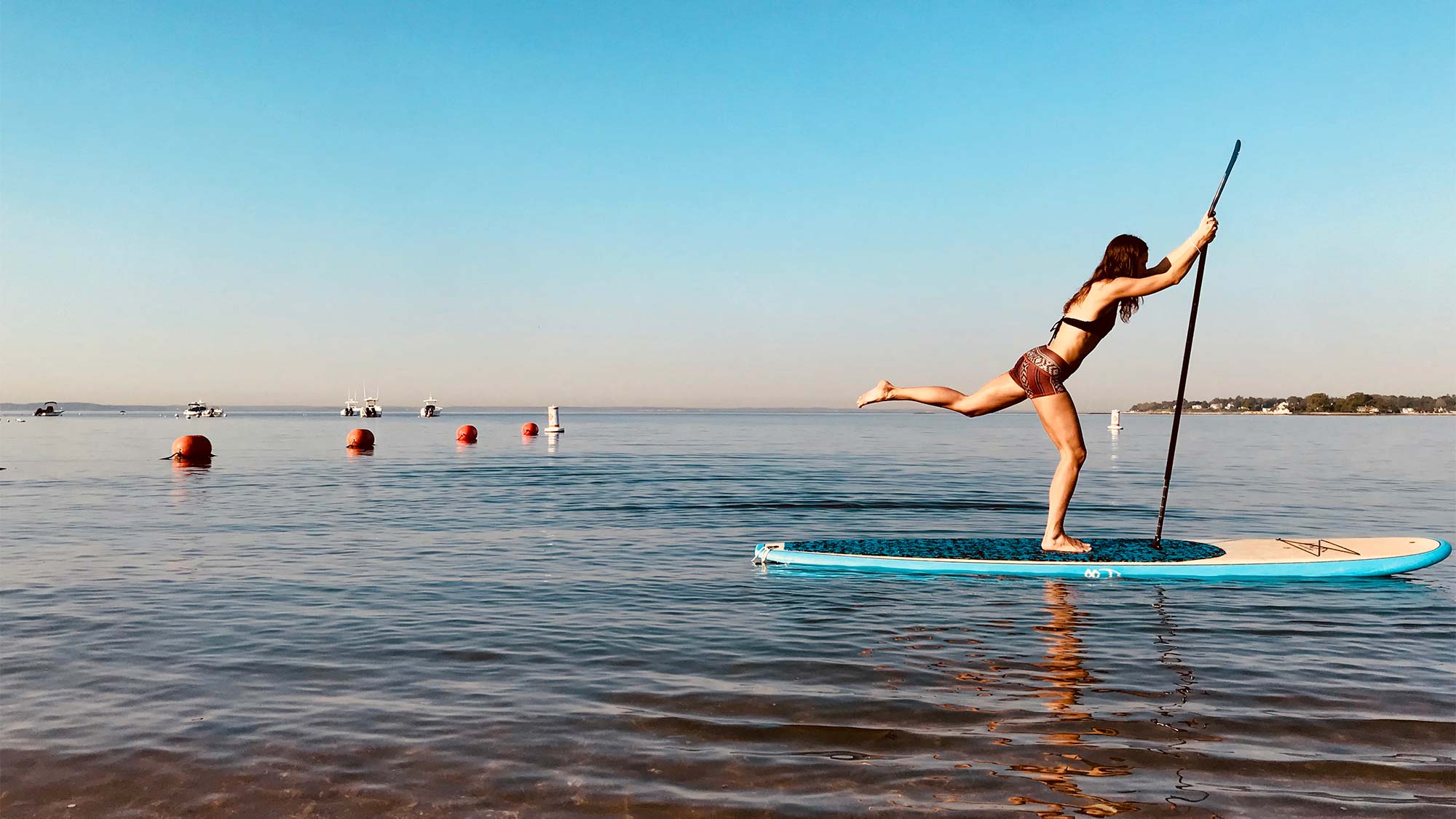
Continue to use the paddle in the opposite hand from your standing leg like you did in Tree Pose, AND extend your standing leg arm like another paddle. Reach out strongly from all five fingertips like you could catch a falling star, or place both hands on the paddle for support. Continue to move with the rise and fall of the waves, all while you lean forward and kick the lifted leg back into Warrior III. Press out through the ball of the foot and hang 10 for a breath or several. No matter. There is always another tide and another opportunity to try. When you’re ready, play with standing on the opposite foot.
See also 5 Prep Poses to Feel Strong and Stable on a SUP
6. Revolved Triangle
![#6-Revolved-Triangle[1] None](https://cdn.yogajournal.com/wp-content/uploads/2018/06/6-revolved-triangle1.jpg?width=3840&auto=webp&quality=75&fit=cover)
You might not believe me, but Revolved Triangle Pose and Half Moon Pose are a bit easier when balancing on a SUP than their non-revolved counterparts. Before you toss seaweed at me for making this suggestion, let me explain why. Much akin to a Tabletop position with four corners being underpinned by hand, hand, knee, and knee, these revolved positions keep the hips and torso aligned, which can level the board in their symmetry. For Revolved Triangle, start in Standing Forward Bend with your feet framing the handle at the center of the board. Step your left foot back so you can ground down the heel and squeegee (move without lifting) that foot toward the left rails. Then squeegee the right foot wide toward the right rails. Keep your hands on the board, bending your knees if necessary to do so, creating those four corners like in a Tabletop position. Grab the rails if they are accessible and stretch the hamstrings and hips. Keep your left hand or fingers on the board, press down on the rails of the board with your feet, hug your legs toward one another, then open your right arm up to the side. Unclench your toes in this advanced expression while you continue to look down or slowly trail with your gaze up at your lifted hand, like a high five to the sky. If accessible, hold this posture for a least three breaths to receive a virtual high five back for your prowess. Move right into the next pose.
See also Summer Challenge: 3 SUP Yoga Starter Poses
7. Revolved Sugarcane
![#7-chapasana[1] None](https://cdn.yogajournal.com/wp-content/uploads/2018/06/7-chapasana1.jpg?width=3840&auto=webp&quality=75&fit=cover)
To go even further in level of difficulty, bend your right knee, crawl your left hand forward, and lift your left leg back behind you. Catch the moment here and then perhaps bend both knees. Grab hold of the lifted foot and once more gaze down for stability, then gaze out to the horizon, heart lifted with head back for a challenging Revolved Sugarcane. Stay for a full breath to marvel at the complement of effort and ease. Repeat poses 6 and 7 on the other side.
See also Challenge Pose: Ardha Chandra Chapasana
8. Boat Pose/Eight-Angle Pose
![#8-astavakrasana[1] None](https://cdn.yogajournal.com/wp-content/uploads/2018/06/8-astavakrasana1.jpg?width=3840&auto=webp&quality=75&fit=cover)
Take Boat Pose in the middle of the board, or Boat on a boat. For more of a challenge, turn toward the left and place your left hand outside your left hip and thread your right arm between your two legs, placing it on the board. You should have two hands down with fingertips facing the left rails and hands on opposite sides of the board’s handle. Cross your left foot over your right, bend your elbows, and hug them in like Chaturanga. Gaze out over the left rails as you press down evenly into your hands and kick the balls of your feet toward the nose or front of the board to lift your hips and send them back. Take a moment back on the surface of the board, then pivot on the seat to face the opposite direction on the board. Play with the arm balance on the other side, crossing right foot over your left and holding for as long as comfortable.
See also Fire Up Your Abs with Eight-Angle Pose
9. Wheel Variation
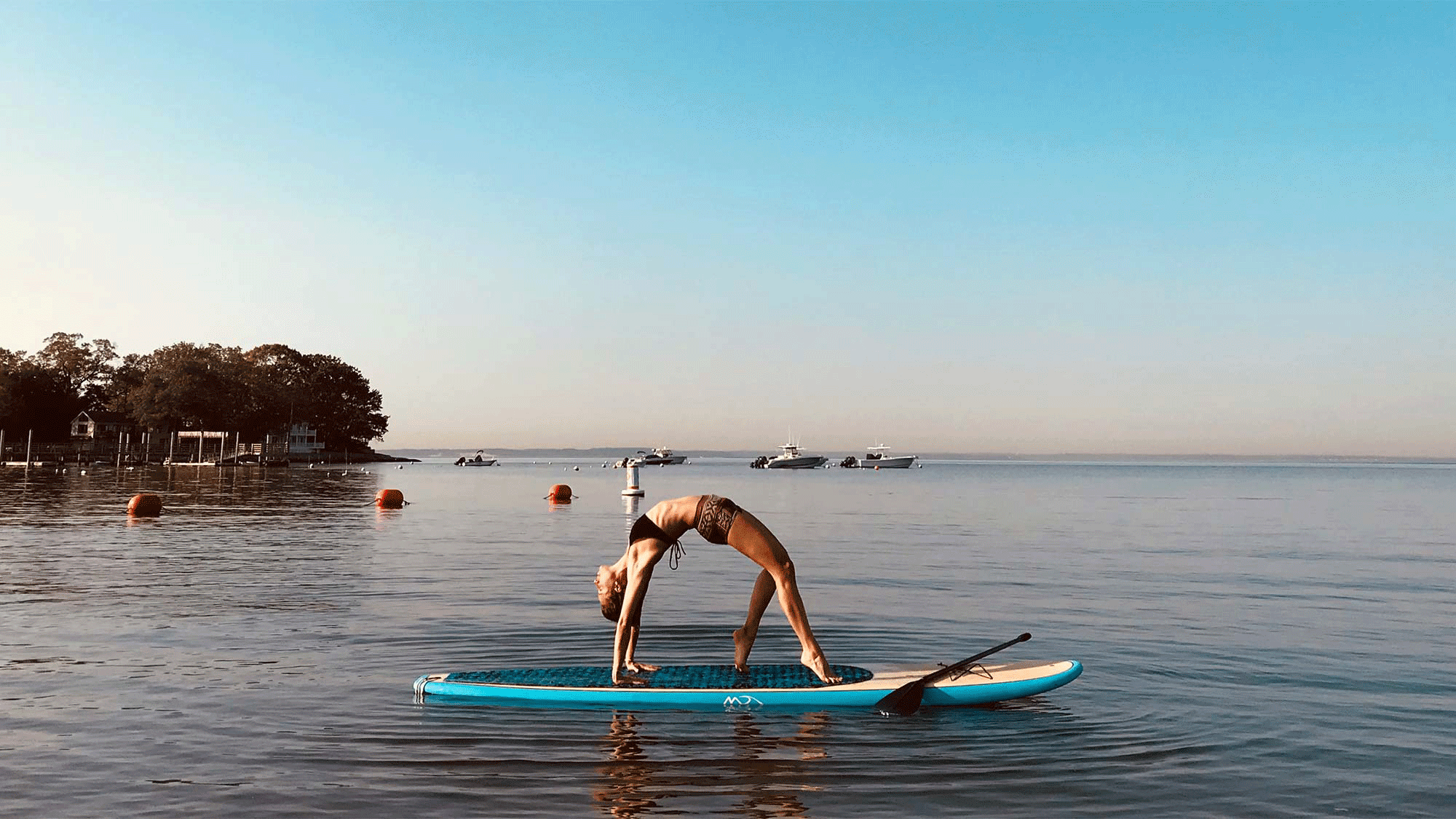
To me, Wheel Pose is one of those poses that remind you that you are on a paddleboard. In other words, there may be a momentary loss of acute attention of the platform when you are in the flow of the movement. On your back, prepare for Wheel with your knees bent and pointing to the sky and your hands flipped, fingers pointing toward the shoulders. Come to the top of your head and pause to integrate the shoulders but also to slow down. Remember where you are and promote balance by pressing equally into both feet and both hands at the same time. Isometrically draw your legs in toward one another and peel one heel off the board. Maybe bend the knee and reach the foot like a mast into the sky. Open your eyes and see the world from a whole other perspective, quite unlike the everyday. Take in the sight, smell, and feel. Right now the sea air is omnipresent. Lower down as slowly as you rose. Relax completely as you drape on top of the board and widen your arms to drop the back of your hands into the sea. Stay for at least five minutes in this floating Savasana while gently rocking, like being comforted by the sea. Repeat, lifting the other leg into the sky.
See also Amy Ippoliti’s New Way to Wheel: A 6-Step Warm-Up
About Our Pro
Danielle Brown is a Academy of Surfing Instructors SUP certified Instructor, a PaddleFIT Coach, and a RYT 200-hour Yoga Teacher. She has been teaching SUP Yoga in Connecticut since 2012 and loves the way it guides her to go with the flow. Danielle leads SUP & Yoga Retreats to escape New England’s winters and trains teachers to assist in building the SUP Yoga community. Learn more at www.thumbsupyoga.com.